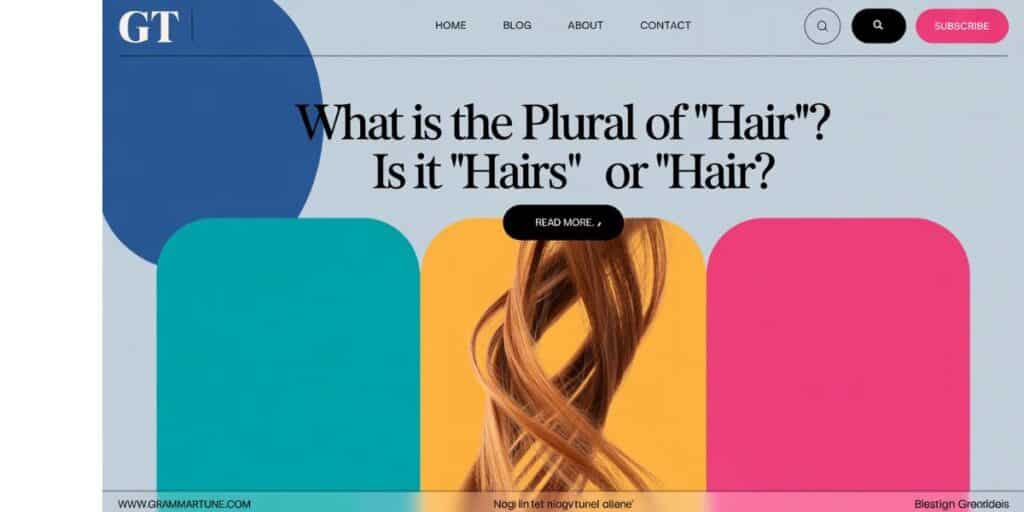What is the Plural of ‘Hair’? Is it ‘Hairs’ or ‘Hair’? This common question often trips people up in everyday conversations and writing.
Understanding the plural of hair isn’t just about grammar—it’s about context. In English, nouns like hair, which can be both countable and uncountable, behave differently depending on how they’re used.
If you’ve ever wondered when to use hairs instead of hair, you’re not alone. Let’s break down the rules, clear the confusion, and make your English sound more natural and precise.
📚 Grammar Basics
✨ What Is the Plural of Hair?
🧠 Are You Good at Plurals?
📏 The Standard Rules for Forming the Plurals
😕 Why Is There Confusion over the Plural of Hair?
🔍 Deep Dive & Usage Tips
👤 Singular and Plural Distinction
🧩 Understanding the Singular Form
🧘 The Singular Essence
📣 Revealing the Plural Form
🤯 The Plural Conundrum
🧬 A Unique Linguistic Trait
🛠️ Usage Tips
🎯 Practical Tips for Usage
🌍 Context Matters
✍️ Precision in Communication
📊 Some Examples and a Table for Clarity
🧾 Examples for Better Understanding
📌 Usage in Context
What Is the Plural of Hair?
The word hair is tricky because it can be both countable and uncountable. In most cases, we say “hair” whether it’s one strand or a full head. But sometimes, “hairs” is also correct.
If you’re talking about individual strands, the word hairs is acceptable. For example, “I found three hairs on my shirt.” Still, most of the time, hair is used as a mass noun.
Must read: Axle or Axel: What’s the Difference?
Are You Good at Plurals?
English plurals can be weird, right? Some words just add an “s,” while others totally change form. Let’s see how well you know them.
Words like “man” become “men,” but hair doesn’t follow that path. It stays the same in most situations, and that’s where it gets interesting.
The Standard Rules for Forming the Plurals
Usually, you just add “s” or “es” to make plurals—cat becomes cats, box becomes boxes. Simple. Logical.
But with uncountable nouns like hair, those rules don’t always apply. That’s where many English learners hit a wall.
Why Is There Confusion over the Plural of Hair?
The confusion comes from how we treat hair—is it a single thing or many tiny things? Depends on context.
People think if one strand is a hair, then multiple should be hairs. Technically, that’s not wrong—but it’s not always right either.
Singular and Plural Distinction
The line between singular and plural isn’t always clear. Some words act like both, depending on meaning.
Hair is one of those words. It doesn’t change from the way other nouns do, which can be confusing.
Understanding the Singular Form
When we say “her hair is long,” we mean the whole thing as one unit. That’s the singular, uncountable use.
You’re not counting strands—you’re describing a general mass. And in English, we treat that as singular.
The Singular Essence
Think of hair like water or sand—things that are hard to count individually. You don’t say “one water” or “one sand.”
Same with hair. It’s a collective noun when describing the entire head of it.
Revealing the Plural Form
Now, if you spot several strands on your shirt, you’d say “three hairs.” That’s the countable version.
Here, each strand is an individual item. This is when the plural form hairs becomes grammatically correct.
The Plural Conundrum
It’s weird, right? You usually say hair, but then sometimes you switch to hairs? That’s the conundrum.
The trick is knowing when the noun becomes countable. That shift is subtle, but important.
A Unique Linguistic Trait
This dual nature is a linguistic oddity. Not many words work this way.
So if you’re puzzled, you’re not alone. Hair is a small word with complex grammar rules.
You will like: What is the Plural of Chief? Chiefs or Chieves?
Usage Tips
Here’s a good rule of thumb: use hair when you’re talking about all of it together. Use hairs when counting individual strands.
Still unsure? Ask yourself: Am I describing a quantity or the whole? That’ll guide you.
Practical Tips for Usage
Avoid saying things like “she has many hairs” unless you mean individual strands. It just sounds off.
Stick with “her hair looks nice” for general appearance. Reserve hairs for specific, countable cases.
Context Matters
Context always matters in English, and hair is no exception. Is it one object or many parts?
Language is flexible—but only when you know the rules. That’s how you avoid sounding unnatural.
Precision in Communication
Getting plural forms right boosts clarity. People won’t have to guess what you mean.
It’s a small detail, but it sharpens your writing and speech. That’s how good communication works.
Some Examples and a Table for Clarity
Let’s clear up confusion with examples and a quick table. Seeing it in action helps.
Below is a side-by-side comparison of correct and incorrect usages of hair vs. hairs.
| Example | Correct Usage? | Why? |
| I brushed my hair. | ✅ Yes | Refers to all the hair together |
| I found two hairs. | ✅ Yes | Talking about individual strands |
| She has beautiful hair. | ❌ No | Should be “hair” for general description |
| There are cat hairs on the couch. | ✅ Yes | Refers to separate strands |
Examples for Better Understanding
- “Her hair is silky.” (mass noun)
- “Five hairs were stuck in the comb.” (countable noun)
- “He lost his hair after chemo.” (general, uncountable)
Notice how each example depends on the situation. One small change shifts the grammar completely.
Usage in Context
Let’s say you’re cleaning a brush. You’d say, “I pulled out several hairs.” Makes sense, right?
But if you’re admiring someone’s style, it’s “Your hair looks great.” Context is everything.
You will like: Buses or Busses: What’s the Correct Plural of Bus?
Conclusion
In conclusion, What is the Plural of ‘Hair’? Is it ‘Hairs’ or ‘Hair’? depends entirely on context. When referring to a collective mass, like all the hair on someone’s head, use hair. But if you’re talking about individual strands—like finding a few on your pillow—hairs are correct.
English often breaks its own rules, and this is one of those exceptions. The key is understanding whether you’re describing a general mass or specific pieces. Once you know that, choosing between hair and hairs becomes simple and natural.
FAQ’S
Can we say “hairs” in English?
Yes, but only when referring to individual strands. For example, “I found three hairs on my shirt” is correct.
Why do we usually say “hair” instead of “hairs”?
Because hair is typically treated as an uncountable noun when referring to a full head or general amount of hair.
Is “hairs” ever grammatically wrong?
Not always. It’s incorrect in general descriptions like “She has nice hairs,” but fine when counting specific strands.
How do I know whether to use “hair” or “hairs”?
Ask yourself: Am I referring to the overall mass or individual strands? Use hair for the former, hairs for the latter.
Do other languages treat hair the same way?
Many languages differ. Some treat hair as countable, so English learners often struggle with this unique grammar rule.

Joulia, a seasoned wordsmith and grammar enthusiast, brings over a decade of blogging expertise to Grammar Tune. With a keen eye for linguistic precision and a passion for making complex grammar concepts accessible, he has helped thousands of readers enhance their writing skills. His engaging teaching style and practical approach to language learning have made him a trusted voice in the online grammar community.







